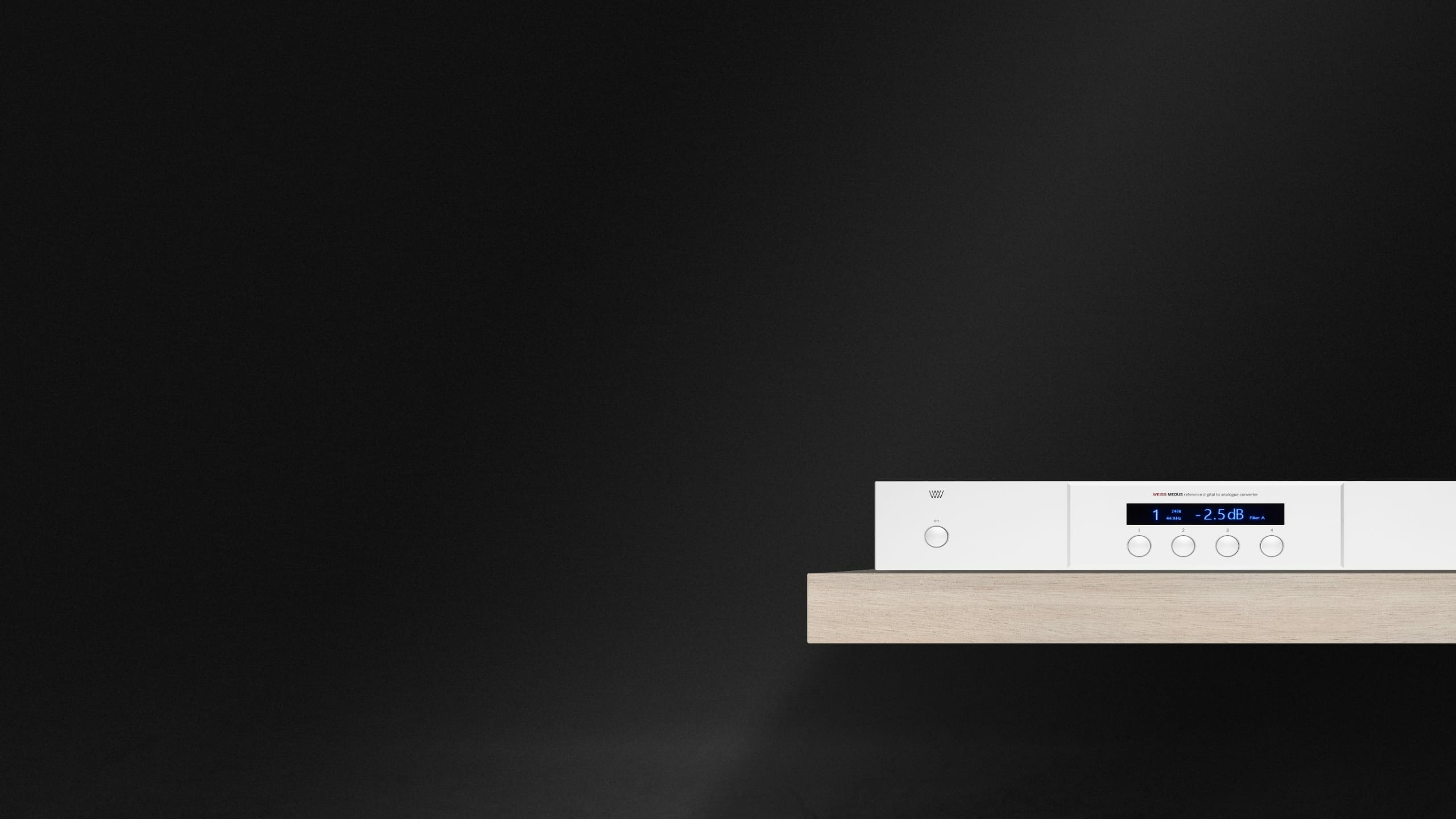NOTHING BETWEEN YOU AND THE MUSIC
PROFESSIONAL-LEVEL digital-to-analog converter
Originating in Weiss Engineering’s product line for professional mastering studios, the MEDUS is truly a zero-compromise DAC. For those seeking the same representation of their music as mastering engineers hear when fine-tuning the audio in the studio, the MEDUS is the unit to get.
Main Features
Weiss MEDUS


Technical Data
Weiss MEDUS
- (3) XLR connectors
- (1) TOSLINK connector (optical)
- (4) RCA connectors
- All inputs accept professional or consumer standard, i.e. accept AES/EBU or S/PDIF signals
- Sampling frequencies; single wire scheme: 44.1kHz, 48 kHz, 88.2 kHz, 96 kHz, 176.4 kHz or 192 kHz on any of the four inputs
- Sampling frequencies; dual wire scheme: 88.2 kHz, 96 kHz, 176.4 kHz or 192 kHz on inputs 1 and 2
- Sampling frequencies of 352.8kHz or 384kHz: On USB input
- DSD64, DSD128: On USB input
- Sampling frequency tolerance: ±80 ppm
- Maximum input word-length: 24 Bits
- (2) XLR Connectors
- (2) RCA Connectors
- Servo-less, DC coupled, short circuit proof output circuitry
- Output impedance: < 100 Ω
- Output level: variable from −4.0 dBu to +27.0 dBu balanced on XLR connectors (−10.0 dBu to +21.0 dBu unbalanced on RCA connectors) with 0 dBFS input, in 1 dB steps (−4 dBu is 0.49 V, +27 dBu is 17.35 V, −10 dBu is 0.245 V, +21 dBu is 8.67 V)
- Output stage: Discrete Class A
- Fs = 44.1 kHz: 0 Hz-20 kHz: within ±0.25 dB
- Fs = 48 kHz: 0 Hz-20 kHz: within ±0.25 dB
- Fs = 88.2 kHz: 0 Hz-30 kHz: within ±0.75 dB
- Fs = 96 kHz: 0 Hz-30 kHz: within ±0.75 dB
- Fs = 176.4 kHz: 0 Hz-40 kHz: within ±0.75 dB
- Fs = 192 kHz: 0 Hz-40 kHz: within ±0.75 dB
Signal To Noise Ratio (SNR) at −40 dBFS input:
- > 129 dB un-weighted
(relative to full-scale output) - > 132 dB A-weighted
(relative to full-scale output)
- < −112 dB @ −3 dBFS input
(0 dBFS = +27.0 dBu) - < −115 dB @ 0 dBFS input
(0 dBFS = +27.0 dBu)
MEDUS
Depth: 30 cm / 11.8 inches
Width: 45 cm / 17.7 inches
Height: 6.6 cm / 2.6 inches
Height with feet: 7.4 cm / 2.9 inches
IR Remote Control
Depth: 2.5 cm / 1 inch
Width: 6.2 cm / 2.44 inches
Height: 16.9 cm / 6.65 inches
A powerful non-switching power supply is used. All sensitive voltages have their own regulators which are separated between left and right channels. The result is an analog output free of “digital noise” and channel crosstalk.
The power switch activates a semiconductor relay which only switches on or off at zero crossings of the mains voltage. This assures a glitch-free power switching. The two mains transformers are toroidal types.
Mains voltage selection is done automatically by measuring the mains voltage before power is applied to the rest of the electronics.
Note: For more detailed product specifications, please refer to the user manual.
Press Reviews
What the media say

Eric’s Hi-Fi Blog
Hi-Fi Blog
MEDUS
Truly outstanding performance — highly recommended.

Hifi+
Hi-Fi Magazine
MEDUS
Whichever way you look at it, the Weiss Medus is a DAC to die for.
Product Downloads
For your MEDUS
Firewire Driver Release notes MacOS
- All
- MacOS
Firewire Driver Release notes Windows
- All
- Windows
MEDUS Brochure (DE)
- 1
- 0.4 MB
MEDUS Brochure (EN)
- 1
- 0.4 MB
MEDUS High Resolution Photos
- N/A
- zip
- 2.6 MB
MEDUS Manual (EN)
- 1
- 10.1 MB

